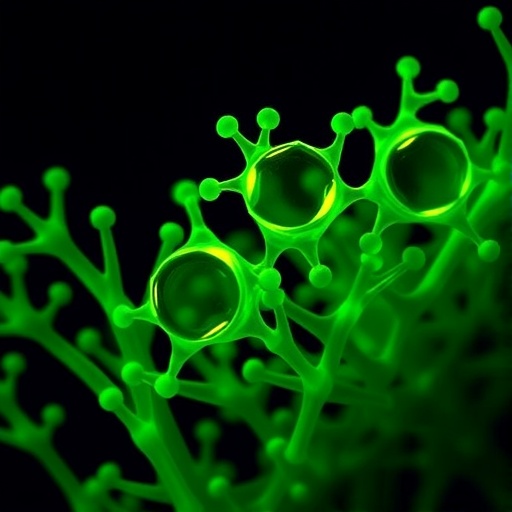
In the intricate process of oxygenic photosynthesis, Photosystem II (PSII) stands as a vital molecular complex responsible for harnessing light energy to drive water oxidation and plastoquinone reduction. However, despite its central role, PSII is inherently vulnerable to photodamage caused by the absorption of excessive or intense light. The damage predominantly affects the D1 protein subunit and other core components, impairing the photosynthetic efficiency and forcing the photosynthetic apparatus into a continuous cycle of repair and reassembly. Recent breakthroughs from the laboratories studying the green alga Chlamydomonas reinhardtii have unveiled remarkable insights into how PSII repair is coordinated through intermediate complexes involving the TEF30 protein, a pivotal regulatory factor now recognized as an ortholog of the plant MET1 protein. These findings, published in Nature Plants in 2025 by Wang et al., illuminate a sophisticated molecular choreography that ensures PSII’s resilience and functional restoration, shedding new light on the fundamental strategies plants and algae employ to sustain photosynthetic productivity.
At the heart of this new understanding lies the characterization of four distinct PSII-repair complexes intricately associated with TEF30, uncovered by state-of-the-art cryogenic electron microscopy (cryo-EM). Each complex represents a specific intermediate state within the PSII repair pathway, highlighting TEF30’s essential role as a molecular chaperone and scaffold that guides the orderly assembly and protection of PSII core components. The detailed structural snapshots include a TEF30-associated PSII core monomer (TEF30-C), two configurationally distinct TEF30–PSII core dimers (designated as TEF30₂-C₂-I and TEF30₂-C₂-II), and a TEF30-bound PSII–LHCII supercomplex (TEF30-C₂S), the latter featuring the strongly associated light-harvesting complex II trimer. These structures reveal unprecedented conformational dynamics and assembly intermediates that underpin effective PSII repair, which is indispensable for photosynthetic organisms exposed to fluctuating light environments.
TEF30 emerges as a crucial mediator that not only facilitates the reassembly of damaged PSII modules but also strategically prevents premature binding of peripheral antennae proteins, which could otherwise disrupt repair and lead to dysfunctional supercomplexes. By clamping onto the stromal surface of PSII core complexes, TEF30 coordinates the integration of the CP43 subunit with the RC47 reaction center module, effectively stabilizing partially disassembled intermediates. This selective “guarding” function ensures that PSII reassembly proceeds in a stepwise, highly ordered manner, minimizing aberrant interactions that might hinder the subsequent restoration of full photochemical activity.
.adsslot_cwmCdgQKfF{width:728px !important;height:90px !important;}
@media(max-width:1199px){ .adsslot_cwmCdgQKfF{width:468px !important;height:60px !important;}
}
@media(max-width:767px){ .adsslot_cwmCdgQKfF{width:320px !important;height:50px !important;}
}
ADVERTISEMENT
One of the more striking revelations from the study concerns the dynamic transformation between the TEF30-associated dimeric forms of PSII. The transition from the initial TEF30₂-C₂-I complex to the alternate TEF30₂-C₂-II variant involves a lateral sliding motion of one PSII core protomer by approximately 22 to 35 angstroms relative to its dimer partner along the dimerization interface. This significant structural rearrangement produces a distinctive zigzagged and contoured surface topology that is conducive to the graded recruitment and accommodation of peripheral antenna complexes. Such plasticity in dimer interface conformation appears paramount in orchestrating the stepwise reconstitution of the fully functional PSII–LHCII supercomplexes, which are essential for efficient light harvesting and energy transfer.
Complementing these findings, the assembly of the TEF30-C₂S complex showcases how TEF30 remains associated even at relatively advanced stages of PSII maturation, including when the strongly bound LHCII trimer is integrated. Here, TEF30 still performs roles of structural stabilization and possibly regulatory fine-tuning, suggesting that its function extends beyond mere early repair intermediates to encompass broader aspects of PSII supercomplex assembly. The interplay between TEF30 and core PSII subunits dictates the orderly progression toward the mature C₂S₂ supercomplex, essential for optimal photoprotection and efficient photosynthesis under natural light conditions.
These discoveries rest on the cutting-edge application of cryo-EM, which has reached a resolution sufficient to discern detailed protein–protein interfaces and conformational nuances critical to the understanding of PSII repair biochemistry. Previous biochemical and genetic studies pointed toward the involvement of auxiliary factors in PSII maintenance, but the precise molecular roles and intermediate assembly states remained largely elusive until now. The high-resolution structural data decisively illustrate how TEF30 acts as a clutching scaffold, selectively modulating protein-protein contacts and facilitating modular assembly pathways. This mechanistic clarity opens new avenues for the design of bio-inspired strategies to engineer photosynthetic robustness, which could have profound implications for crop productivity and artificial photosynthesis systems.
What makes the PSII repair pathway particularly fascinating is its highly coordinated nature, where multiple intermediate states and auxiliary proteins form an intricate network of interactions and checkpoints. The report by Wang and colleagues highlights that rather than a simplistic linear repair event, PSII restoration involves a spectrum of temporally and structurally distinct complexes orchestrated by TEF30 and potentially other yet to be fully defined factors. This multifaceted assembly line likely integrates environmental signals and intracellular cues, modulating repair kinetics to optimize photosynthetic efficiency under stress. Understanding these nuances is critical not only for plant biology but also for biotechnological applications seeking to enhance photosystem durability.
The biological significance of such a complex repair framework is amplified in photosynthetic organisms like Chlamydomonas reinhardtii, which often inhabit highly variable and stressful light habitats. The ability to efficiently recycle and rebuild PSII ensures survival and sustained energy capture despite the incessant photodamage risks. TEF30-associated intermediate complexes can be seen as guardian checkpoints within this quality control system, guaranteeing that defective or incomplete assemblies do not propagate impaired photochemistry. Thus, this research delineates a blueprint for how algae—and by extension plants—maintain photosynthetic integrity under fluctuating environmental pressures.
Moreover, the discovery of this TEF30-mediated mechanism enriches our understanding of the evolutionary conservation and diversification of PSII repair processes. Given that TEF30 is an ortholog of the plant MET1 protein, these insights suggest that similar molecular strategies may be widespread among photosynthetic eukaryotes, albeit with species-specific adaptations. Future studies exploring TEF30 and MET1 homologs in other organisms will deepen our grasp of the evolutionary pressures shaping photosynthetic machinery repair and resilience, potentially identifying universal principles applicable across taxa.
The structural plasticity observed in PSII dimers underscores the broader theme that membrane-bound photosynthetic complexes are not static entities but dynamic assemblies capable of significant conformational remodeling. This adaptability facilitates the accommodation of diverse protein subcomplexes during repair and functional modulation. Such revelations challenge longstanding paradigms that viewed photosystems as rigid complexes, instead promoting a model in which protein mobility and rearrangements are integral to function and maintenance. These insights resonate with emerging concepts in membrane protein biology, where flexibility often underpins biological regulation.
In practical terms, decoding the PSII repair intermediates opens promising paths for agricultural innovation. By manipulating TEF30 expression or modulating its interaction surfaces, it may be possible to accelerate PSII repair or enhance photoprotection, leading to crops with improved tolerance to high light stress and better yield stability. Additionally, the molecular blueprints unveiled by cryo-EM may inform synthetic biology approaches aiming to recreate or modify photosynthetic machinery in heterologous systems, enabling sustainable bioenergy generation or carbon fixation technologies.
Importantly, the work on TEF30-associated complexes showcases the power of integrative structural biology in unraveling complex cellular processes. Combining cryo-EM with biochemical and genetic analyses allowed the researchers to correlate structural intermediates with functional states, bridging the gap between molecular architecture and physiological relevance. This multidimensional approach is poised to accelerate discoveries not only in photosynthesis but across diverse biological fields where transient and dynamic complexes dictate cellular outcomes.
As research on PSII repair continues to evolve, the identification of TEF30’s multifaceted roles marks a milestone in photosynthetic biology. The detailed depiction of intermediate complexes and their transitions provides a vital reference point for future explorations into photosystem maintenance mechanisms. Such foundational knowledge is crucial for a comprehensive understanding of how photosynthetic organisms optimize energy capture and safeguard their core photochemical engines against the relentless challenge of photodamage.
In conclusion, the elucidation of TEF30-mediated PSII repair intermediates via high-resolution cryo-EM represents a transformative advance in our grasp of photosynthetic resilience. By uncovering detailed molecular snapshots of critical assembly stages, Wang et al. have charted a complex yet elegant pathway of PSII reconstitution in Chlamydomonas reinhardtii. Their findings not only clarify fundamental aspects of photosystem repair but also inspire innovative approaches to enhance photosynthetic efficiency in natural and engineered systems. The ability of TEF30 to choreograph the precise assembly and protection of PSII components stands as a testament to evolutionary ingenuity, offering profound lessons with far-reaching scientific and practical implications.
Subject of Research: The structural and functional characterization of TEF30-associated intermediate complexes involved in the repair and reassembly of Photosystem II in Chlamydomonas reinhardtii.
Article Title: Roles of multiple TEF30-associated intermediate complexes in the repair and reassembly of photosystem II in Chlamydomonas reinhardtii.
Article References:
Wang, Y., Wang, C., Li, A. et al. Roles of multiple TEF30-associated intermediate complexes in the repair and reassembly of photosystem II in Chlamydomonas reinhardtii. Nat. Plants (2025). https://doi.org/10.1038/s41477-025-02036-3
Image Credits: AI Generated
Tags: Chlamydomonas reinhardtii researchcryogenic electron microscopy in biologyD1 protein subunit in photosynthesisintermediate complexes in PSII repairmolecular complexes in photosynthesisNature Plants 2025 publicationphotodamage in PSIIphotosynthetic productivity in algaePhotosystem II repair mechanismsplant and algal resilience strategiesregulation of photosynthetic efficiencyTEF30 protein function in algae



